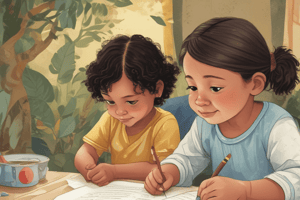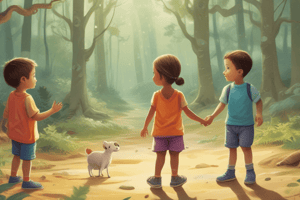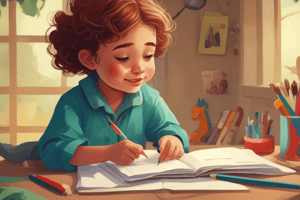Podcast
Questions and Answers
When setting individualized child goals in a learning program, what is the MOST important factor to consider?
When setting individualized child goals in a learning program, what is the MOST important factor to consider?
- Adherence to a strict timeline for achieving each goal to ensure consistent progress tracking.
- Standardizing goals across all children to ensure equitable assessment and comparison of developmental milestones.
- Focusing primarily on cognitive skills development to enhance academic performance and future success.
- Balancing the child's learning needs, parental input, and the child's interests to create relevant goals. (correct)
Why is documenting observations of children considered important in early childhood education?
Why is documenting observations of children considered important in early childhood education?
- To ensure compliance with standardized testing requirements.
- To tailor learning experiences by understanding each child's progress, behaviors, and social context. (correct)
- To quickly assess a child's abilities for immediate grading.
- To create a detailed record for administrative purposes only.
In the example provided, what key elements are included when recording an observation of Aria?
In the example provided, what key elements are included when recording an observation of Aria?
- Detailed nutritional information about the child's meals and snacks.
- A summary of weekly lesson plans and activities.
- Child's name, date, time, what the child did, child's words, and feelings or social context. (correct)
- A list of required materials for the activity.
After making detailed observations, what is the NEXT suggested step in the programming guide?
After making detailed observations, what is the NEXT suggested step in the programming guide?
How does Aria's sand play activity demonstrate scientific thinking?
How does Aria's sand play activity demonstrate scientific thinking?
What is the primary goal when linking children's learning to relevant frameworks?
What is the primary goal when linking children's learning to relevant frameworks?
According to the note, what should educators focus on when linking learning to frameworks, principles, or theorists?
According to the note, what should educators focus on when linking learning to frameworks, principles, or theorists?
How does incorporating Aria's love for outdoor exploration align with the EYLF (Early Years Learning Framework) Learning Outcomes?
How does incorporating Aria's love for outdoor exploration align with the EYLF (Early Years Learning Framework) Learning Outcomes?
What is the MOST significant way outdoor experiences contribute to the National Quality Standard (NQS)?
What is the MOST significant way outdoor experiences contribute to the National Quality Standard (NQS)?
How does referencing theorists like Piaget and Vygotsky enhance the understanding of a child's development?
How does referencing theorists like Piaget and Vygotsky enhance the understanding of a child's development?
In what specific ways do outdoor experiences support Developmental Milestones?
In what specific ways do outdoor experiences support Developmental Milestones?
How does linking outdoor exploration to the 8 Aboriginal Ways of Learning enhance a child's educational experience?
How does linking outdoor exploration to the 8 Aboriginal Ways of Learning enhance a child's educational experience?
According to the Phoenix Cups framework, what needs are met through outdoor movement and exploration, and building competence through discovery?
According to the Phoenix Cups framework, what needs are met through outdoor movement and exploration, and building competence through discovery?
What is the NEXT step after capturing initial observations in the Notepad?
What is the NEXT step after capturing initial observations in the Notepad?
What is the primary purpose of the Butler Programming Diary?
What is the primary purpose of the Butler Programming Diary?
What should educators reflect on during the 'Evaluate and Adjust' stage?
What should educators reflect on during the 'Evaluate and Adjust' stage?
What is the purpose of using simple prediction charts as part of the Future Learning Plan?
What is the purpose of using simple prediction charts as part of the Future Learning Plan?
When does a learning cycle typically conclude?
When does a learning cycle typically conclude?
What should educators primarily do when reviewing observations in the Butler Programming Diary?
What should educators primarily do when reviewing observations in the Butler Programming Diary?
What is the MAIN purpose of using a Floor Book?
What is the MAIN purpose of using a Floor Book?
Flashcards
Child Goals in OWNA
Child Goals in OWNA
Individualized goals based on a child's learning needs, parent input, and interests.
Recording Observations
Recording Observations
Capturing a child's voice, actions, behaviors, and social context during activities.
Documenting Observations
Documenting Observations
Inputting a detailed version of the observation into OWNA, including analysis, planning, and links to relevant frameworks.
Linking Learning
Linking Learning
Signup and view all the flashcards
Vygotsky's theory
Vygotsky's theory
Signup and view all the flashcards
Land Links
Land Links
Signup and view all the flashcards
In-the-moment observations
In-the-moment observations
Signup and view all the flashcards
Butler Programming Diary
Butler Programming Diary
Signup and view all the flashcards
Evaluate and Adjust
Evaluate and Adjust
Signup and view all the flashcards
Using the Butler Programming Diary
Using the Butler Programming Diary
Signup and view all the flashcards
Floor Book
Floor Book
Signup and view all the flashcards
Outdoor Program Diary
Outdoor Program Diary
Signup and view all the flashcards
Study Notes
- The programming guide provides a step-by-step process for educators to capture authentic observations, document, analyze, plan, implement, track, and evaluate children's learning and development within the OWNA (Our World, Naturally, and Authentically) framework.
Capturing Authentic Observations (Step 1)
- Individualized goals which are based on children's learning needs, parent input, and interests are added into OWNA.
- These goals are linked to specific areas of development, like social, emotional, cognitive, or physical skills.
- Documented observations, achievements, and strategies are used to support each child in reaching goals.
- Over time, educators review progress, adjust goals, and tailor learning experiences to support each child's growth.
- A example goal states "Incorporate Aria's love for outdoor exploration, as shared by her parents, by providing more nature-based learning experiences such as sensory walks, gardening, and outdoor science experiments."
- A notepad is used to quickly capture a child's voice, actions, behaviors, and social context during spontaneous or structured activities.
- Taking quality photos enhances documentation.
Example Observation of Aria
- Child's Name: Aria
- Date & Time: April 20, 2025, 9:30 AM
- What the Child Did: Aria scooped dry sand into a cup and poured it into another, added water, mixed it, and made sand shapes.
- Child's Words: "It's too crumbly," "Now it's working!" "This one is wetter—it's stronger."
- Feelings or Social Context: Focused and independent, experimenting through sensory play.
Document, Analyze, and Plan in OWNA (Step 2)
- Input a detailed version of the observation into OWNA, including analysis, planning, and links to relevant frameworks.
Observation Details
- Aria sat in the sandpit with the two plastic cups and a small bucket of water and created a row of shapes, adjusting the water amounts as appropriate.
- Aria was showing persistence, problem-solving, and curiosity, experimenting with cause and effect through sensory exploration.
Analysis of Observation
- Aria's play demonstrates scientific thinking and problem-solving skills.
- Aria explored how wet and dry sand behaved differently, adjusting her methods to achieve her goal, persistence, critical thinking, and curiosity are shown.
Plan for Future Learning
- Goal: Extend Aria's scientific thinking and problem-solving by introducing new materials and tools.
- Planned Activities: Provide funnels, watering cans, and various containers for further exploration.
Linking Learning to Relevant Frameworks
- It is essential to connect observations to multiple frameworks and theoretical perspectives to ensure a holistic and meaningful understanding of each child's development.
- Link to EYLF (Early Years Learning Framework) Learning Outcomes.
- Connect to Principles & Practices.
- Address National Quality Standard (NQS).
- Reference theorists (Vygotsky, Piaget, Erikson).
- Track with Developmental Milestones.
- Embed 8 Aboriginal Ways of Learning.
- Apply Phoenix Cups Framework.
Important Note
- Focus on the frameworks, principles, or theorists of greatest relevance to the specific learning experience or goal.
- Linking to frameworks, practices, or theorists that directly support the child's current learning focus will make the plan more purposeful and aligned.
EYLF Learning Outcomes
- Outcome 2: Children are connected with and contribute to their world.
- Aria's engagement with nature-based activities strengthens her connection to the environment and fosters an appreciation for the natural world.
- Outcome 4: Children are confident and involved learners.
- Hands-on outdoor experiences will encourage Aria to explore, investigate, experiment, and promote confidence and curiosity.
Principles & Practices
- Principle 2: Partnerships with families.
- Incorporating Aria's love for outdoor exploration, builds on the home-school connection and aligning with her interests.
- Practice 1: Play and Pedagogy.
- Nature-based activities support play-based learning and allow for exploration and creativity in a natural setting.
NQS (National Quality Standard)
- Quality Area 1: Educational Program and Practice.
- Outdoor experiences allow Aria to explore scientific concepts and engage in meaningful learning based on interests.
- Quality Area 3: Physical Environment.
- Outdoor environments enhance learning opportunities and provide a rich setting for active engagement and sensory exploration.
- Quality Area 5: Relationships with Children.
- Nature-based experiences strengthens the educator-child relationship by supporting individual interests and learning preferences.
Theorists
- Jean Piaget:
- Piaget's theory of cognitive development aligns with outdoor exploration. Aria deepened her understanding of the world through sensory and hands-on experiences.
- Lev Vygotsky:
- Outdoor activities encourage learning through social interaction and collaboration, reflecting Vygotsky's concept of learning through shared experiences.
Developmental Milestones
- Cognitive: Aria will deepen her understanding of cause and effect and natural systems through outdoor play and exploration.
- Physical: Gardening and sensory walks will strengthen gross and fine motor skills.
- Language: Outdoor experiences provide opportunities to expand vocabulary as she describes the natural world and activities.
Aboriginal Ways of Learning
- Land Links: Place-based learning, linking content to local land and place.
- Aria's outdoor exploration connects learning to the local environment, fostering a deeper sense of place and belonging through nature-based experiences.
Phoenix Cups
- Physical Cup: Needs for outdoor movement and exploration
- Mastery Cup: Building competence through discovery and experimentation
Implement the Planned Extension (Step 3)
- Capture in-the-moment observations again using the Notepad.
Example
- Child's Name: Aria
- Date & Time: April 22 2025, 3:30 PM
- What the Child Did: Aria used a funnel and watering can to compare the flow of water finding the watering can flowed faster.
- Child's Words: “This one's slower."
- Feelings or Social Context: Focused and curious, experimenting through different tools.
Use the Follow-Up Feature in OWNA
- Aria selected a small watering can and a plastic funnel from the outdoor play equipment and filled both with water pouring them over a gravel filled tray.
- She noticed the water released faster from the watering can than the funnel.
- Throughout the activity comparative language was used, hypothesised, and tested different variables.
- Used to link relevant ELG Learning Outcomes, Principles & Practices, NQS, Theorists, Developmental Milestones, 8 Aboriginal Ways of Learning, Phoenix Cups.
Track Progress (Butler Programming Diary) (Step 4)
- Document participation in the Butler Diary.
- Outdoor Experiences Entry: A.B - Observation (22/4)
- Group/Individual Observations: Document entry eg. Aria observation/extension – (22/4)
Evaluate and Adjust (OWNA) (Step 5)
- Reflect on learning and plan next steps in OWNA.
Reflection
- Aria showed high engagement, used comparative language, and initiated experimentation to make simple predictions.
Future Learning Plan
- Introduce simple prediction charts and recording outcomes.
- Encourage using more scientific vocabulary.
Ongoing Learning Cycle and Review
- A learning cycle concludes when:
- Children make noticeable progress toward learning goals.
- Interest fades or children master the concept.
- The topic no longer matches their evolving needs.
- Flexibility to adapt plans based on children's emerging interests and developmental needs.
- Start a new goal in Owna once a goal is achieved.
Using the Butler Programming Diary for Reflection and Planning
- Review daily posts, observations and identify milestones or patterns of interests.
- Reflect on what worked well and what could improve, evaluate how needs were met and if learning outcomes were achieved.
- Plan future activities.
- Develop programs based on reflections, observations, and children's current needs and interests.
Daily Posts Example
- Children engaged in activities encouraging exploration, creativity, and social interaction.
- Children worked in the sandpit using cups, funnels, and watering cans to explore how water moves.
- Children painted pictures using different textures and colors, and they engaged in a group game of “Follow the Leader,”
- Daily posts can consist of one paragraph or bullet points etc.
- Relevant ELG Learning Outcomes, Principles & Practices, NQS, Theorists, Developmental Milestones, 8 Aboriginal Ways of Learning, and Phoenix Cups were linked.
- To continue exploring textures and building new activities with listening and following instructions were introduced.
- Connect daily posts to the Butler diary by adding the date of the post to the areas the learning occurred.
Using a Floor Book
- To record key moments, children's statements, and important discoveries.
- To add photos and drawings from the activity to show what the children did.
- To involve children, enable them to add their own drawing and thoughts.
- To plan for the future, look back at the floor book to help plan activities based on the children's interests and learning needs.
- The floor book helps create a visual record of learning that children can see and contribute to for tracking progress and planning next steps.
Outdoor Program
- The Butler Outdoor Program Diary is used to document and reflect on outdoor play across the yards with each room recording observations, interests, skills, and experiences.
- Educators review entries from all three yards to identify common themes, developmental needs, and interests, then collaboratively plan a flexible, shared outdoor setup.
- The above helps create a cycle of observation, reflection, and planning that supports meaningful outdoor learning.
Studying That Suits You
Use AI to generate personalized quizzes and flashcards to suit your learning preferences.




